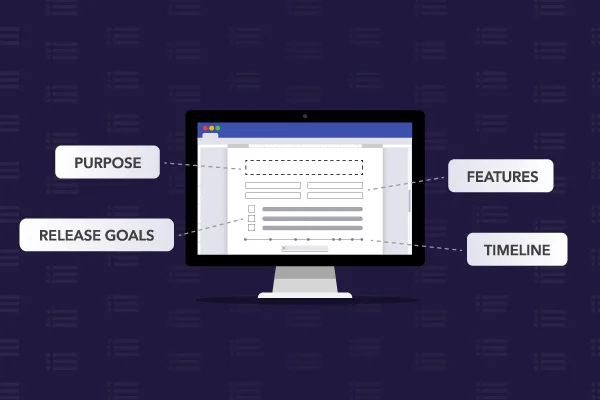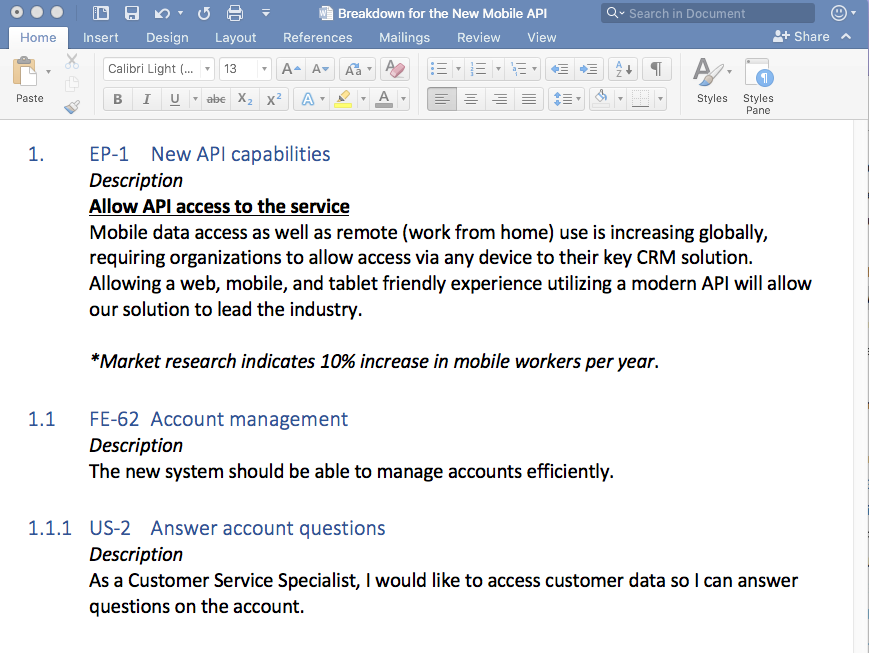
How to Write a PRD (Product Requirements Document) — With Examples
A product requirements document (PRD) outlines the requirements and functionality of the product you’re going to build so that your development team understands what they're building, who it's for, and the purpose it will serve for its end users.
While lengthy, highly detailed product requirements documents are not as common in today's Agile world as they once were, they are still valuable for getting all stakeholders on your team aligned on the product you're going to build. For some businesses, such as those building extremely complex products and those in highly regulated industries who need extensive documentation, a comprehensive PRD is essential.
But even for companies using an Agile or hybrid development framework, a basic PRD will help ensure that everyone on your team is on the same page before you start building. And that helps everyone work more efficiently and stay focused on a common goal.
In this blog, we will dive into each of these elements below. Continue reading or jump ahead to the section that interests you most:
Back to top
What Is a Product Requirements Document (PRD)?
The product requirements document (PRD) is usually created by the product manager before the development team starts building, though it should always be a collaborative effort. A PRD is a product manager’s best friend. It sets the course for the release. And it ensures that you deliver what customers want — on time.
Every stakeholder involved with the release — developers, testers, project managers — should know what’s in the PRD.
PRDs typically include the following elements: purpose, features, release criteria, and timeline.
What About an Agile Requirements Document?
Thorough documentation seems like the opposite of the Agile framework. But Agile development teams certainly benefit from using PRDs, too.
In Agile development, you create user stories instead of traditional requirements. So, an Agile requirements document gathers the user stories that are essential for a release.
It still covers the same elements — purpose, features, release criteria, timeline. But an Agile requirements document typically does this in a more flexible task board or dynamic, interactive document, rather than in a static document.
After all, a PRD doesn’t need to be a novel. You can cover the core essentials of a product release in a one-pager — and ensure that your development team is able to remain Agile.
👉🏼 READ: How to do an Agile hybrid in a regulated industry >>
Back to top
What Should Be Included in a PRD (Product Requirements Document)?
A Product Requirements Document (PRD) is crucial for aligning your development team and stakeholders on the product's goals and specifications. Successful product releases start with a product requirements document that contains these five elements:
- Purpose: Define who the product is for and why it's being built.
- Features: Outline what features the product will have.
- Release Criteria: Set the goals and standards for the release criteria.
- Timeline: Provide an estimated timeline for the product's development and release.
- Stakeholder Review: Ensure all key stakeholders review and approve the document.
Back to topEvaluating Requirements Management Solutions?
Get our Requirements Management Software Buyer's Guide to learn 5 questions to ask when comparing traceability and compliance solutions.
How to Write a PRD (Product Requirements Document)
Writing an effective PRD is important to get your development team aligned toward a common goal.
While you may be tasked with writing the actual document, creating the PRD should be a collaborative effort. You’ll work with multiple stakeholders across development. This ensures that everyone is on the same page about the purpose and goals of the product release. And it ensures that what you’re developing will fulfill your customers' needs — and that it can be completed on time.
Remember: the overall goal of a PRD is to define what you’re going to build — not how you’re going to build it.
Here are five steps to writing an effective PRD for a successful product release.
1. Define the Purpose of the Product
Everyone in development needs to be aligned on the purpose of the product. The purpose needs to drive the features.
The purpose should outline:
- What problems this product solves or pain points it addresses.
- Who will use the product - both end users and other customer stakeholders.
- Why it’s important, i.e. how the product will provide value to your customers.
Every stakeholder should agree on the purpose — and be aware of it as development progresses.
2. Break the Purpose Down Into Features
Your next step is to determine the feature requirements for the release. Every feature should support the overall purpose of your product.
A best practice for setting feature requirements is to first define themes and initiatives.
A theme aligns the organization for years.
Some examples of a theme might be:
- API
- Performance
- Mobile
Themes can cross multiple years and release cycles.
Initiatives are used to align development efforts to achieve thematic goals. And initiatives can help you be sure that product development is heading in the right direction. An initiative might span multiple themes, for instance incorporating features for API, performance, and mobile.
From there, an initiative breaks down into feature requirements.
Want to see what this process looks like IRL?
▶️ Watch our on-demand webinar:
From Planning a Theme to Setting Requirements >>
3. Set the Goals For the Release Criteria
Setting the right goals for your release criteria will help you achieve the stated purpose of the product release.
Your goals should be:
- Easy to understand.
- Actionable.
- Achievable.
- Measurable.
And release criteria should cover five areas — functionality, usability, reliability, performance, and supportability:
Functionality
You’ll need to define the minimum functionality you need in order to achieve the purpose and release the product. An example is defining requirements that are critical to the release.
Usability
You’ll need to ensure the product is easy to use. An example is determining the scope of user testing — and what you’ll do with those results.
Reliability
You’ll need to determine that your product is reliable. An example is making sure it can recover from system failure.
Performance
You’ll need to set a baseline for performance. An example is determining how fast your product needs to load.
Supportability
You’ll need to determine that the release can be supported. An example is ensuring it can be installed and configured by users.
4. Determine the Timeline
Every product release needs a goal release date — even if it’s a rough estimate.
Your timeline and estimated release date should give you flexibility to adapt to a change in priorities. But it can also help restrict scope creep by limiting how many features stakeholders can add without substantially altering your timeline or release date.
Managing the release process — and hitting that target release date — can be tricky. That's why it's helpful to take the time up front to estimate a realistic timeline and estimated release date, and document both in your PRD.
Struggling with missed release deadlines and poor communication across your team?
▶️ Watch our on-demand webinar:
How to Fix Your Release Process >>
5. Make Sure Stakeholders Review It
When you create a PRD, it’s vital that all key stakeholders review the document.
This can be tricky when you’re managing a requirements document in Microsoft Word. The last thing you want is to have multiple stakeholders making comments on different versions of the requirements document, which you then have to consolidate, then make sure everyone has the latest version by the time development starts.
It’s a best practice to have a central solution where you can manage requirements reviews online. Then, you can ensure that everyone is looking at the most recent version of the document. And you can go back and track exactly what has changed and who changed it.
It’s also important that everyone involved in development of the product knows what’s on the PRD. It should be shared with everyone from developers to testers to managers.
Need some best practices for writing requirements?
📑 Get the Guide:
9 Tips for Writing Useful Requirements >>
Back to top
PRD Template: A Product Requirements Document Example
Many teams use Microsoft Word to create and manage PRDs.
Here’s a product requirements document example in Microsoft Word:
Keeping a PRD up-to-date is difficult in a tool like Microsoft Word. It’s hard to ensure accuracy when requirements are tracked in one place, while development and testing teams are using other tools. Making sure everyone has access to the latest version is a challenge. It’s harder to collaborate. And it’s practically impossible to be Agile.
That’s why many development teams use requirements management software to create a PRD. With a proper requirements management tool like Helix ALM, you can eliminate information silos. Everything from your PRD to testing and defect management can be tracked and connected in one place. Requirements are always up-to-date. And it can be used by every development team, whether they follow Waterfall or Agile development processes, or even a hybrid methodology.
Here’s an example of that same PRD in Helix ALM:
An Agile requirements document can also be created in a task board. This gives you at-a-glance visibility of the status of all of your requirements.
For example, in this Kanban board, you’ll see how user stories (requirements) are being reviewed and implemented.
If you’re developing in sprints, like most Agile teams, you can use Helix ALM to monitor progress of each sprint. You’ll see which user stories have been implemented and validated.
Back to top
PRDs and Traceability
Writing a PRD is just one step towards efficient development and a better release process. Successful releases also depend on thorough testing and speedy bug resolution.
So, it’s a best practice to have a tool — such as Helix ALM — where you can track user stories (or requirements), tests, and issues all in the same spot. Then, you can even use your PRD to ensure test coverage by creating test cases from user stories. You can trace your test results backwards to your user stories, and forwards through to bug resolution.
✏️ Learn 6 exercises to strengthen traceability >>
In Helix ALM, this is done through a traceability matrix (which is generated automatically by the tool):
This end-to-end traceability helps ensure that you've built exactly what you set out to build, that your product will work the way you intended it to, and that it serves the purpose it is supposed to serve for your customers.
Back to topTry Helix ALM: A Better Way to PRD
Interested in a better way to write a PRD and manage releases? You can try Helix ALM free — and see how the right PRD and requirement & test management solution can improve alignment and collaboration across your entire development lifecycle. Or, watch this demo of Helix ALM to see exactly how it:
- Automates traceability.
- Lets you easily configure any type of workflow.
- Automatically traces test cases back to requirements.
- Accommodates FMEA, ASIL, Hazard Analysis, and more with built-in risk tracking.
▶️ WATCH A DEMO TRY HELIX ALM FREE
Editors Note: This blog first appeared in September, 2018. It was updated with additional content in March, 2023.
Back to top




